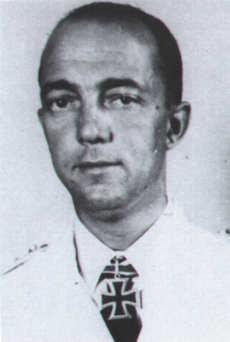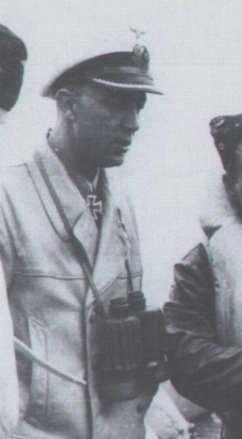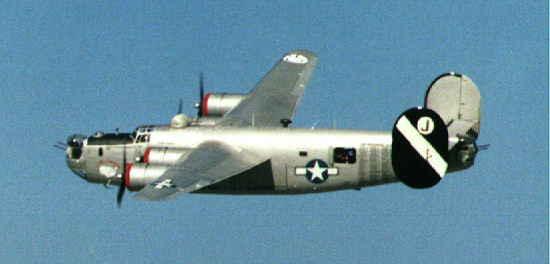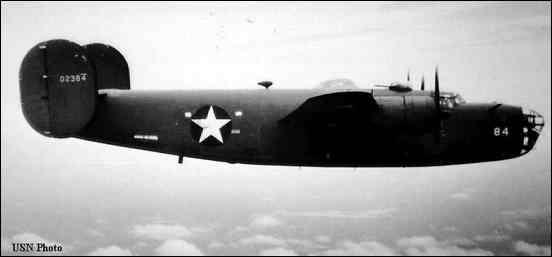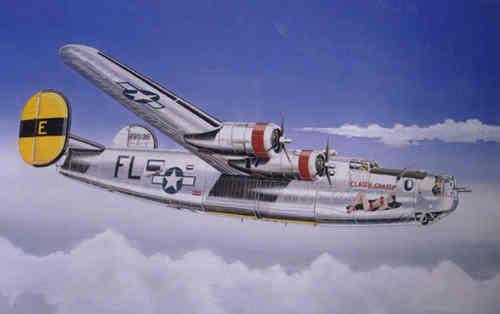Home
Mark
Poyser
1999
How
I Used the Internet to Find My Uncle’s Killer
When
I was a kid, my mother would occasionally tell me stories about her
childhood. She was part of a family of four: her parents were Herbert
and Frances Chapman, and she had an older brother named Frank. They
lived in the small town of Glossop, Derbyshire, which is about thirty
miles south of Manchester. It was an old cotton mill town, partly
rural, with moors and farms nearby. She and her brother would often
play together, he being only one year older. I heard stories about
their adventures, but the tone would be melancholy since my Uncle
Frank lost his life at sea while still a young man during World War
II. His death was hardly ever discussed, but I distinctly recall
hearing about the grim day when the British Government’s
notification was delivered to the Chapman household. It was a
heartbreaking experience for the entire family. Young Frank, an
unexceptional fellow at that early time in his life, was still loved
for his good nature and easygoing attitude. He had a bit of the
practical experimenter in him, and an interest in radio as a teenager
(this was in the 1930’s). Hearing those stories over the years
created a dim, but still distinct impression on me as I was growing
up. Since my father had no siblings, my Uncle Frank, had he lived,
would have broadened the dimensions of our narrow family tree, and
made life a little richer for us all.
The
specifics about how he met his demise at sea were never discussed.
All I learned was that he was on a ship in the Mediterranean,
possibly as a short-wave operator, and that he lost his life ‘early’
in the war. Were the Italians responsible for his ship going down? No
one seemed sure. I attributed the reticence about discussing the
subject to the acute pain of the loss. As a result, I went through my
life with just a teaspoon of knowledge about the fellow, not giving
it much thought, figuring that I’d never find out more about
him.
Now
it’s 1999, and I’m in the process of reading several books
about the Second World War. Some focus on naval engagements and
provide details about the battleships, submarines, aircraft carriers,
and other instruments of war. I’m drawn to the technical
details, such as how big the guns were, what sort of ordinance was
used, and the tactics employed by both sides. Books by John Keegan
are excellent at portraying the experiences of the men when under
fire, and the terror and stress on board those ships that ultimately
fail to make it back to port. Reading the stories can give a sense of
the emotions the sailors experienced. All in all, it was a very dirty
business.
One
night I was re-reading chapters about the Battle of the Atlantic
(WWII), and it sparked a renewed interest about what happened to my
Uncle Frank. Could I find out more about his brief naval career?
Could the Internet be a resource in this effort? It was late that
evening, past 10 PM, but I pulled myself out of bed, and decided to
give it a try.
The
Internet contains an enormous amount of information, but it’s
often hard to find what you are looking for. There are search engines
that help, but all too often they return a tremendous number of web
pages to consider, which can be daunting. Still, it pays to take a
look at, say, the first 30 entries if for no other reason than to
stimulate one’s own ‘search string’ vocabulary.
Selecting the correct words is very important when undertaking a web
search, and this is especially important when dealing with military
matters. Generally, one takes the plunge by examining some sites,
followed by a return to the search engine for another go with
different words, repeating this process until either something is
found or fatigue sets in. A diligent search can easily take a couple
of hours. The focus shifts back-and-forth between extremely specific
search strings (which often return nothing) and more general ones.
Sometimes switching search engines will help. The rule to employ is
“follow your nose.” It’s not much different than being
in a research library in that respect.
Well,
I had to start somewhere and see what the prospects were. I figured
that since my uncle died while in the British Navy, there was a
chance of finding his service record, along with details about the
ship he was assigned to. I decided to start with the “Ask
Jeeves” site ( http://www.ask.com
) to find more about my Uncle Frank. This site has some technical
advantages over a plain search engine. Though it limits the number of
returns, your request is sent to several of the big-name portals,
which saves time. Also, the site has its own database of ‘quick
load’ pages that have been reviewed, which reduces the junk to
plough through.
When
entering a search string, it is useful to try different ways of
expressing what you want. To start with, I would enter "Historical
British Navy Ships", but the parsing of that entry might
result in links to “General British History”,
“Royal Navy Official Site”, or even
“Yachting”. You never know what you’re
going to get. The Royal Navy only wants to recruit new members, and
as such does not have a database of sunken warships for you to check
out (apparently that would hamper the recruitment effort). Other web
sites would offer only a tiny amount of information. One fellow in
Denmark had a 2x6 table listing major events in World War II for his
country [!] and for England. That was it. The total number of words
on the page was about 300. Yet he’s in the search engines. Only
by visiting each site is it possible to really know if it might
contain what you are looking for. You cannot enter something like,
“Sailors who died in the service of the British Navy during
World War II in the Mediterranean”, and expect anything
sensible. Either the result is a big fat zero, or there are links to
too many irrelevant sites. The best approach is to try smaller
chunks, and use a sixth sense as to how to proceed.
As
luck would have it, I finally landed on the Commonwealth War Graves
Commission web site ( http://www.cwgc.org/cwgchome.htm
) and tried out searching their database. It looked promising.
I selected British (as opposed to Canadian, Australian,…),
entered: Chapman, F (they want first initial only), and got
back a table listing four “F. Chapman”s. I clicked on the
first link, and the following page was displayed:
http://www.cwgc.org/cwgchome.htm
In
Memory of
FRANK CHAPMAN
Ordinary
Telegraphist
C/JX 270699
H.M.S.
Grove, Royal Navy
who died on Friday, 12th June 1942.
Age 20.
Additional
Information: Son of Herbert Rockley Chapman and Frances
Chapman, of Glossop, Derbyshire
|
|
Commemorative
Information:
Memorial: CHATHAM NAVAL MEMORIAL, Kent, United
Kingdom
Grave Reference/
Panel
Number: 59, 3.
Location: The
Memorial overlooks the town of Chatham and is approached by a
steep path from the Town Hall Gardens.
|
Yep,
that's him. I had an odd feeling upon first viewing this page. Seeing
the entry in black and white suddenly made him real again. I also had
thoughts about how those who fought in great wars, though they may
have lost their life, often were part of a struggle to make the world
better. And, since nations maintain memorials to those individuals,
they are not quickly forgotten. You can actually point to
something that declares, “We care, and remember.” So, my
uncle has a legacy (which now extends to the Internet). I wonder I’ll
ever be listed in some fashion on the web.
Now
I have the date, and the name of the ship he was on, the H.M.S.
Grove. Frank was an 'ordinary' telegraphist, whatever that means.
Hmm. Maybe working with electronics runs in the family (I’m a
computer programmer). Anyway, back to search engines. I tried using
the date: June 12, but that wasn’t promising. Among other
things, It returned an O. J. Simpson link! (That was the date of the
infamous double murder.) I tried naval sites, but didn't know what
class of ship the H.M.S. Grove was, although I suspected it was one
of the smaller ones. The only thing left to do was to brute-force the
effort, visit different locations and scroll through pages of mostly
irrelevant data. Also, many of the military sites are part of
web-rings that take you as far afield as the Napoleonic or
Vietnam War, so that particular feature doesn’t help much. Some
other places only display pictures of ships. It’s not the World
Wide Web; sometimes it appears to be the World Wide Scrapbook!
Finally, I stumbled upon a superb, privately managed site (
http://freespace.virgin.net/aim.direct/WW2_British_Ships_Destroyers.htm
) that contained an extensive amount of tabular data about British
destroyers. There was no search capability, so one has to read the
contents (or invoke the browser’s find function) to see if it
contains what you want. An encouraging sign is that the Grove is
listed near the top as being sunk in 1942 in the Mediterranean.
Scrolling down the very long page, I encountered:
http://freespace.virgin.net/aim.direct/WW2_British_Ships_Destroyers.htm
|
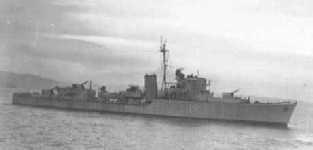
A
Type 2 ship “Oakley” (later it became the Polish
“Kajawiak”)
|
|
ESCORT
DESTROYERS
HUNT classes
TYPE 2, 33 ships, 6 lost and
1 not repaired - 1,050 tons, 27 knots, 6-4in, 170 crew, 1941-42
|
|
GROVE,
12th June 1942, Eastern Mediterranean, off Sidi Barrani, Egypt (c
32-00'N, 25-30'E) - by 1 torpedo from German U.77.Returning
to Alexandria after escorting supply ships to Tobruk (North
African Campaign)
|
So,
it was a German U-boat that was responsible for the sinking of the
ship, and not the Italians.
June
1942 was close to the end of the successful phase of the Germans’
North African Campaign. This was before Montgomery was assigned to
the area and well before the British/American landings near Morocco
in November 1942. In the spring of that year Rommel made great
progress, threatened to take Egypt, and with it, the Suez Canal. In
fact, key members of the German command thought that success in that
area would be of great strategic significance, especially if the
centrally located, British-held island of Malta could be taken. But
Hitler only allocated three divisions and provided limited naval
support to the theater. Rommel’s efforts were further hampered
because his troops’ supplies were often intercepted and
destroyed by the Royal Navy.
As
part of his move eastwards towards Egypt, Rommel decided to conquer
the British held fortress of Tobruk, and it eventually fell on June
21. Some German officers were uncertain about the value of Tobruck,
because it did not seem to threaten their lines too much, and an
attack would mean a further expenditure of precious of troops and
materiel. But take it they did. Undoubtedly, the H.M.S. Grove
contributed to the British resistance there, and perhaps as a
by-product, to ultimate victory in the theater, months later, by the
British Eighth Army.
It
turns out that the Italian Navy was active in the eastern
Mediterranean Sea in the month of June 1942. During that time, the
British had dispatched a convoy (“Vigorous”) of 11 ships
and their escorts from Haifa and Port Said, which reached Tobruk on
the 13th. On or before the 14th, an Italian
battlefleet (consisting of two battleships, two heavy and two light
cruisers, plus destroyers) sailed south from Taranto to destroy it.
In response, the convoy tried to head to Malta, but ultimately
returned to Alexandria minus one cruiser, three destroyers and two
merchant ships. Hard fighting took place over a three-day period;
losses on both sides were mostly due to Allied and German aircraft.
The Italian battlefleet never got closer than 200 miles from Tobruk,
but in the Western Mediterranean they were more successful. Another
Allied convoy (“Harpoon”) was attacked by Italian ships and
aircraft, resulting in the loss of four (of six) merchant ships and
two destroyers plus heavy damage to four other escorts. All of this
activity probably led to my family’s belief that the Italians
were responsible for Uncle Frank’s demise. After all, who’s
going to have access to U-boat logs during a war?
For
me, the interesting part is that the listing for H.M.S. Grove
identifies (U-boat) U-77 as the agent that sunk the ship. And to
think that I enjoyed the movie “Das Boot”! I’m a
little ashamed of myself at the moment.
It
turns out that I was already familiar with a site that contains just
about all the information one would ever want to know about U-boats.
It has to be seen to be believed. I had found it very informative and
even had a link to it on my home page! So I hopped over (
http://uboat.net
). Selecting for U-77, brought up the following information:
http://uboat.net/boats/u77.htm
U-77
Type
VIIC
|
Laid
down 28 March 1940 Vegesacker Werft, Bremen-Vegesack
Commissioned
18 Jan 1941 Oblt. Heinrich Schonder (Knights Cross)
|
|
Commanders
|
01.41
- 09.42 Kptlt. Heinrich Schonder
E
when my uncle's ship was sunk (06.42)
09.42 - 03.43
Oblt. Otto Hartmann
|
|
Career
14 patrols
|
01.41
- 04.41 7th Flotilla (Kiel) training
05.41 - 12.41 7th
Flotilla (St. Nazaire) front boat
01.42 - 04.42 23rd Flotilla
(Salamis)
05.42 - 03.43 29th Flotilla (La Specia) E
when my uncle's ship was sunk (06.42)
|
|
Successes
|
13
ships sunk for a total of 37,431 tons including the British
destroyer HMS Grove (1,050 tons) 3 ships damaged for a
total of 8,109 tons
|
|
Fate:
|
Sunk
at 0115hrs on 28 March, 1943 east of Cartagena, Spain, in position
37.42N, 00.10E by 4 depth charges and 1 bomb from 2 British Hudson
aircraft (48 & 233 Sqn.). 38 dead, 9 survivors. 36 men,
including the commander, are buried in the cemetery at Cuacos de
Yuste (Caceres - Spain).
|
A
Type 7 submarine. Just finished reading about it. It carries 14
torpedoes, has a crew of about 50, a range of 15,000 miles, 17 knots
surface, and 7 knots submerged. Actually, a rather primitive craft,
not much better than World War I types in most respects. There were
also these tidbits about the flotillas the boat was assigned to:
|
Emblem
|
General
|
Miscellany
|
|

|
7th
Flotilla
Bases:
06.38 - 09.40 Kiel
09.40 -
05.41 Kiel / St. Nazaire
06.41 - 05.45 St. Nazaire
U-boat
types:
VIIB, VIIC, VIIC41 and UA
|
U-96
was assigned to this flotilla, and that boat was the subject of
the movie “Das Boot”. U-96 (like U-77) was a Type
VIIC.
Both
boats were in this flotilla for all of 1941, until December, when
U-77 was transferred to the Mediterranean (to Flotillas based in
Greece & Italy).
|
|

|
23rd
Flotilla
Bases:
09.41 - 05.42 Salamis (Greece)
U-boat
types:
VIIB and VIIC
|
|
|

|
29th
Flotilla
Bases:
12.41 - 08.43La Specia (Italia)
U-boat
types:
VIIB & VIIC
|
The
Wild Onager - U-338 This emblem was inspired by the launch of
U-338 which broke its mooring and sank a small tugboat. It was
adapted as the emblem for the 29th Flotilla in Las
Specia in the Mediterranean. The only boats to display the emblem
(besides the U-338) were U-77, U-371 and U-617.
|
So,
the U-boat was sunk. What about Kapitänleutnant Schonder? He
wasn't on board when U-77 went down. Who is he, and what happened to
him? It turns out that his listing in the table for U77 contains a
link for Kptlt.
Heinrich Schonder, where there’s probably a small
biography and an image or two. This is getting a little eerie. I’m
about to view the face of the man who was responsible for my uncle’s
death. After all this time. Over fifty years since the event, and I’m
now about to see what he looks like. There’s no way that anyone
else knows what I’m about to discover. The hair on the back of
my neck is tingling a bit. A frisson envelops me, sitting alone in my
study, in the dead of the night. It’s past 2 AM in the morning,
and very quiet. The only sound is the squeak of the chair.
No
sense in hesitating at this point. Let's look up ol’ Heinrich,
and see what we get.
http://uboat.net/men/schonder.htm
|
Heinrich
'Hein' Schonder
Korvettenkapitän (Crew 1934)
Born 23
July, 1910 Erfurt
Died 24 June, 1943 North Atlantic
|
Kapitänleutnant
Heinrich Schonder
(Kapitänleutnant is equivalent to
the U.S.Navy’s Lieutenant)
|
|
Ranks
|
26Sep,1934
Seekadett
1Jul,1935 FähnrichzurSee
1Jan,1937
OberfähnrichzurSee
1Apr,1937 LeutnantzurSee
1Apr,1939
OberleutnantzurSee
1Sep,1941 Kapitänleutnant
1Jun,1943
Korvettenkapitän
|
|
Decorations
|
01/10/1939
: Iron Cross 2nd class (EK II)
01/12/1939 :
Ubootskriegsabzeichen 1939
23/07/1940 : Iron Cross 1st class
(EK I)
19/08/1942 : Knights Cross (-60-) F
|
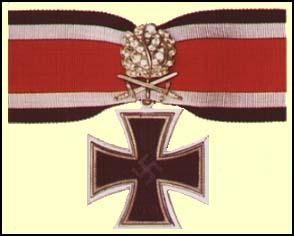
|
|
U-boat
Career
|
U-51
VIIB I WO 08.38 - 08.39
U-53 VIIB 2 patrols, 72 days 08.39 -
11.39
U-53 VIIB Commander in deputize 12.39 - 01.40
U-9
IIB I WO; 4 patrols, 44 days 01.40 - 04.40
U-58 IIC 4 patrols,
72 days 07.40 -11.40
U-77 VIIC 10 patrols, 222 days 01.41 –
09
U-200 IXD2 1 patrol, 12 days 12.42 - 06.43
|
|
Heinrich
Schonder started his naval career in April 1935. After some months
on the torpedo boat Falke he changed in January 1938 to the U-boat
force.
He
rode for two years on several U-boats as watch officer, before he
took over in June 1940 the Type IIC U-boat U-58. He sank on 4
patrols, mostly in the North Atlantic, 4 ships. He left U-58 and
commissioned in January 1941 the Type VIIC U-boat U-77. After
three patrols in the North Atlantic he managed on 16 December
1941, the break through into the Mediterranean. He rode
in the Med 6 patrols and sank among other ships the British
destroyer HMS Kimberley and the frigate HMS Grove.
'Hein'
Schonder left U-77 in September 1942 and commissioned 3 months
later the Type IX-D2 U-boat U-200 which was sunk on her first
patrol with all hands on 24 June, 1943 southwest of Iceland by a
RAF Liberator aircraft.
|
U-boat
deployment into the Mediterranean
|
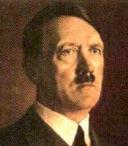
|
The
Germans dispatched U-boats into the Mediterranean because they
were disappointed with the Italians’ submarine performance
in that theater. Beginning in October 1941, and for the next
eight weeks, Hitler ordered 16 U-boats to relocate from the
Atlantic to the Mediterranean. U-77 was
part of that transfer.
The
Straits of Gibraltar was the area through which all boats
entering the Mediterranean had to traverse and was a very
dangerous part of the journey as it is very narrow and was always
heavily patrolled by allied vessels. According to one source, due
to the nature of the currents, once a U-boat entered the
Mediterranean Sea, it could not return to the Atlantic.
The
U-boats committed to the Mediterranean meant that, following
Germany’s 11 December 1941 declaration of war on the United
States, Donitz’s request of 12 boats (all Type IX’s)
for operation in the Western Atlantic was denied. The German
Naval Staff only approved the deployment of 6 (and one of those
developed mechanical problems). But, though small in number, they
were responsible for a large number of sinkings from January to
June of 1942.
|
http://uboat.net/ops/mediterranean.htm
|
From
Sept 1941 to May of 1944 Germany managed to send 62 U-boats into
the Mediterranean. All these boats had to navigate the dreaded
British-controlled Straits of Gibraltar where 9 U-boats where
sunk while attempting passage and 10 more had to break of their
run due to damages. No U-boats ever made it back into the
Atlantic and all were either sunk in battle or scuttled by their
own crews.
The
Mediterranean was a very dangerous arena for the U-boats; all
around it were dozens of allied air base from which hundreds of
radar-equipped aircraft hunted them. The Mediterranean is very
clear and calm body of water that made escape more difficult for
the U-boats.
|
http://uboat.net/men/schonder.htm
(continued)
So,
U-77 slipped into the Mediterranean past Gibralter. There was a scene
in “Das Boot” showing a similar attempt. It’s a very
risky maneuver. So that's what he looks like. Yikes! He’s the
sort of fellow Central Casting would send over to play the ‘heavy’.
A Knights Cross recipient. Congratulations Nazi bastard! The U-boat
crews, and especially their officers, were the most ideological and
fanatical in the German armed services. Herr Schonder started his
career in 1935, which was when the flotilla first came into being,
and he almost certainly was a gung-ho militarist. I make a mental
note not to name any son I have, ‘Heinrich’.
Well,
he died somewhere in the North Atlantic, but on another boat: U-200.
Is there any further information about how he met his end? Let's look
up U-200:
http://uboat.net/boats/u200.htm
|
U-200
Type
IXD2
|
Laid
down 3 Nov 1941 AG Weser, Bremen
Commissioned 22 Dec 1942
Kptlt. Heinrich Schonder (Knights Cross)
|
|
Commanders
|
12.42
- 06.43 Kptlt. Heinrich Schonder
|
|
Career
1 patrol
|
12.42
- 05.43 4th Flotilla (Stettin)
06.43 12th Flotilla (Bordeaux)
|
|
Successes
|
None
|
|
Fate
|
Sunk
24 June, 1943 southwest of Iceland, in position 58.15N, 25.25W, by
2 depth charges from a British Liberator aircraft (Sqdn.
120/H). 67* dead (all crew lost). * Included in the figure for
loss of life are 7 members from the German special force
"Brandenburg" unit.
|
58.15N,
25.25W is about 500 miles due south of the western tip of Iceland.
That patch of ocean is completely empty. The submarine went down in
icy waters, far from any land. Good riddance, I say. Follow up
research revealed that U-200 was sunk by Liberator “H”
(planes are identified by letter) of British Squadron 120, dispatched
from Reykjavik, Iceland and piloted by an Australian, A.W. Fraser
(see appendix). At the end of June a new moon was in the sky, a
condition preferred by U-boat commanders, since it made detection by
Coastal Command’s anti-U-boat forces more difficult.
The
Brandenburg special force unit traveling on that particular U-boat
was composed of “coastal troops” who were destined for
South Africa, of all places. It was part of a bizarre scheme to
incite rebellion amongst the Boers. U-200 departed on June 12 from
Kiel, one year to the day, after the H.M.S. Grove was sunk. It
was not, at that time, a direct participant in the Battle of the
Atlantic (which was a fight over merchant shipping to Britain and to
the Soviet Union).
|
Consolidated
B-24 Liberator
|
|
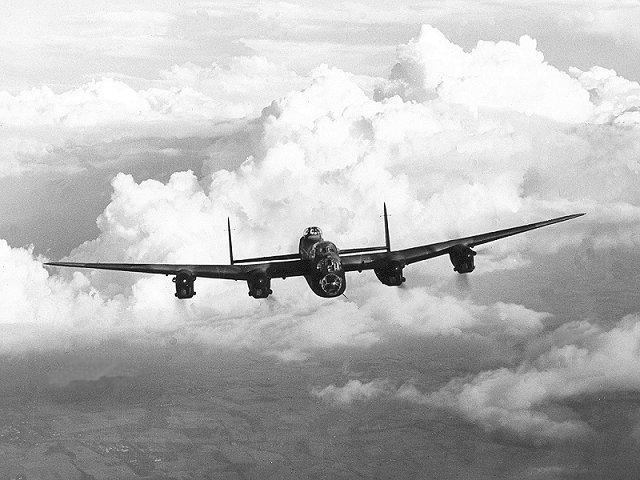
|
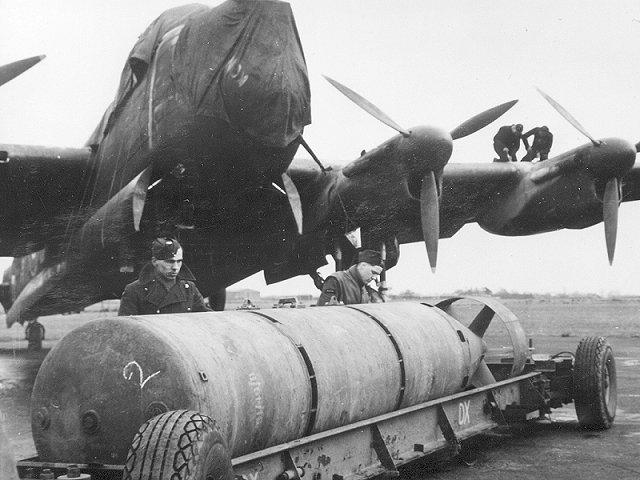
|
|
Range
2100mi Speed 300mph Ceiling: 28,000 Armament: 10 x .5”
machine guns
|
More
recollections: The Consolidated B-24 Liberator, introduced in 1941,
was a long-range, four-engine bomber that carried a load of 8,000
pounds. 18,000 were built. The British flew 1700, and later in the
war the Liberators were equipped with 10-centimeter radar and
powerful searchlights which made them deadly. (The radar could detect
a periscope and was undetectable by U-boat electronics when first
introduced.) In May of 1943, the month before U-200 was sunk, the
Germans lost 41 U-boats and that month marked the turning point in
the Battle of the Atlantic. Donitz, commander of the U-boat forces,
and the inventor of the ‘wolf pack’ strategy withdrew the
boats and conceded defeat in the face of the increasing and effective
anti-submarine warfare. There would be more battles fought in the
seas, but the days of easy hunting by the Germans were over.
All
in all, a strange adventure. Here are two men, my Uncle Frank and his
adversary, Heinrich Schonder, linked decades later (albeit tenuously)
within the databases that exist on the World Wide Web. And, I was
able to reconstruct the details about the events, not in Germany, and
not in England, but thousands of miles away in Los Angeles. Close
enough in time to be emotionally meaningful, but far enough away to
be almost magical. Neither Frank nor Heinrich could possibly imagine
this happening from their vantage point of the 1940’s. It makes
one wonder what things will be like another fifty years from now.
Will a distant relative be able to look up your history, and
relive, for a brief moment, some of the important times of your life?
Probably so. And a whole lot more.
Appendix
The
Exploits of Alexander William Fraser
Details
about the sinking of U-200 can be found in Clay Blair’s Hitler's
U-Boat War : The Hunted 1942-1945 (Hitler's U Boat War, Vol 2).
They are included in the narrative above. Regrettably, Alexander
William (or “A.W.”) Fraser, who established a good service
record, did not live to survive the war. Searching the Internet
brought up the following information:
http://yard.ccta.gov.uk/cwgc/register.nsf
Commonwealth
War Grave Commission Site
|
In
Memory of
ALEXANDER WILLIAM FRASER DFC and Bar
Flight
Lieutenant
404063
Royal
Australian Air Force
who died on
Tuesday,
4th July 1944. Age 29.
Additional
Information: Son of Alexander William and Rhoda Maria Fraser;
husband of Margaret Fraser, of Millaa Millaa, Queensland,
Australia.
|
|
Commemorative
Information:
Cemetery:
LISBURN CEMETERY, County Antrim, United Kingdom
Grave
Reference/
Panel Number: Sec. A. Grave 390.
|
http://www.awm.gov.au/database/roh.asp
Australian War Memorial Site
|
|
Fraser,
Alexander William DFC & BAR
Number: 404063
Rank:
Flight Lieutenant [Flt Lt]
Unit: ATTD RAF (Farnborough)
Service: RAAF
Conflict: 1939-1945
Date of Death:
04/07/1944
Place of Death: United Kingdom
Cause of Death:
Accidental
Memorial Panel: 122
Cemetery or Memorial
Details:
Next Of Kin:
Notes:
Source: AWM148 Roll of
Honour cards, 1939-1945 War, Air Force
|
http://www.awm.gov.au/database/photo.asp
Australian War Memorial Site
|
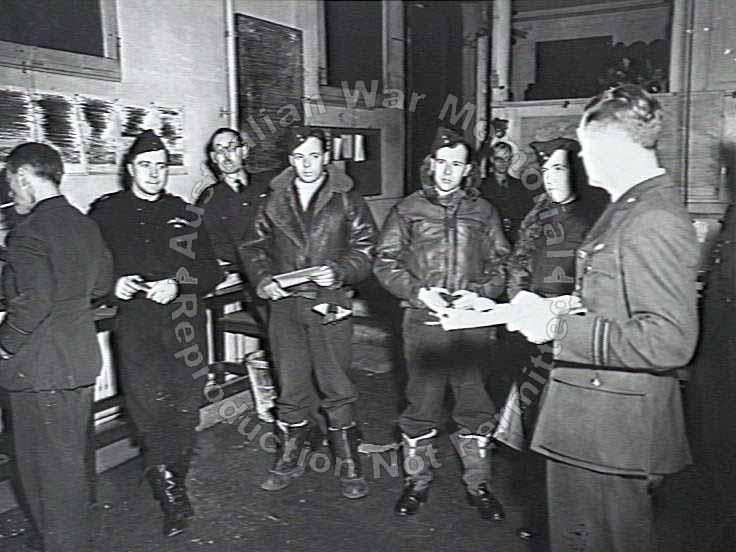
|
UK.
C. 1943-05. Group portrait of a Coastal Command Liberator Crew
being briefed. Second from the left is their Australian Captain
404063 Flying Officer A. W. Fraser of Qld, who was awarded the DFC
1943-03-10 for protecting convoys.
|
|
photo
not available
|
Western
Atlantic Ocean. 1943-06-23. A RAF Coastal Command Liberator
aircraft commanded by Flight Lieutenant A. W. Fraser, of Qld,
attacked and subsequently sank this German U-boat, which is seen
receiving direct hits forward of the conning tower.
|
|
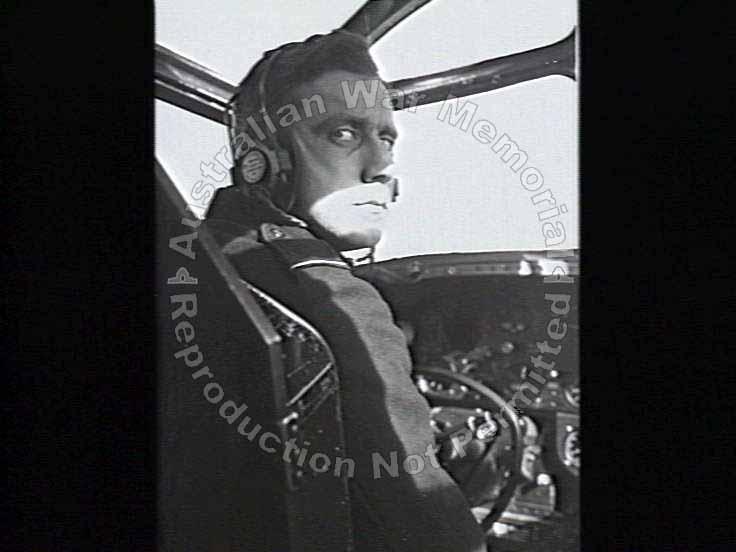
|
UK.
C. 1943-05. Portrait of Captain 404063 Flying Officer A. W. Fraser
of Qld, at the controls of a Coastal Command Liberator aircraft,
who was awarded the DFC on 1943-03-10 for his work in
anti-submarine escort sorties and protection of convoys.
|
|
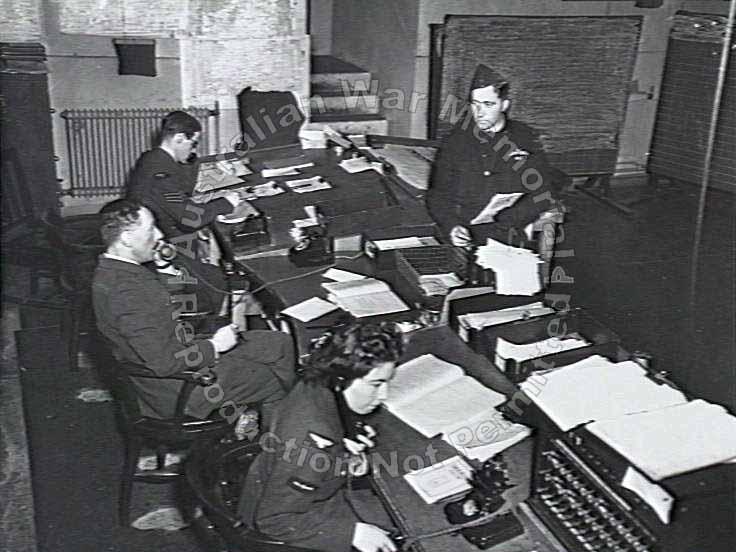
|
UK.
C. 1943-05. Portrait of 404063 Flying Officer A. W. Fraser DFC of
Qld (right), Captain of a Coastal Command Liberator aircraft, as
he tells his story on return from patrol. He was awarded the DFC
on 1943-03-10 for his work in protecting convoys, and for the
outstanding keenness and judgment he displayed UK. C. 1943-05.
Portrait of 404063 Flying Officer A. W. Fraser DFC of Qld (right),
Captain of a Coastal Command Liberator aircraft, as he tells his
story on return from patrol. He was awarded the DFC on 1943-03-10
for his work in protecting convoys, and for the outstanding
keenness and judgment he displayed
|
|
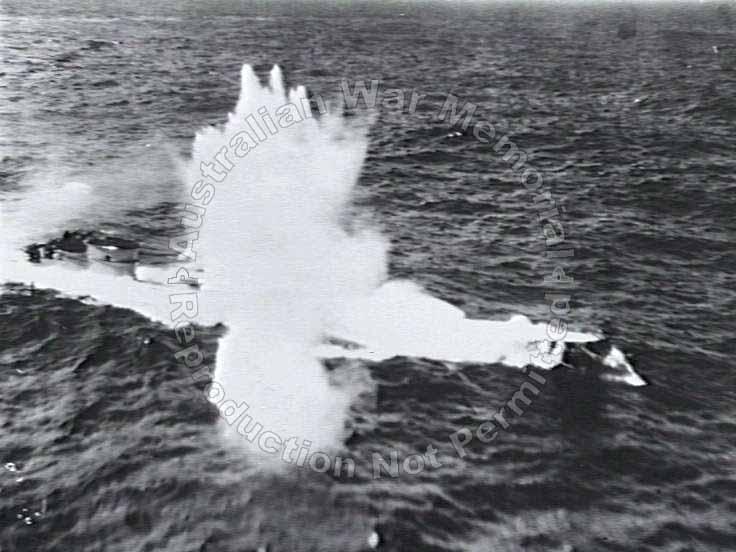
|
At
sea in the North Atlantic. 1943-06-22. 404063 Flight Lieutenant
(Flt Lt) A. W. Fraser DFC and Bar of Millaa Millaa, Qld, succeeded
in sinking a German U-boat in the face of intense gunfire from the
submarine. Although the aircraft, a Coastal Command Liberator of
No. 120 Squadron RAF, was damaged, the pilot brought it back to
base and made a perfect landing. For his "magnificent example
of determination to destroy the enemy in the face of opposition",
Flt Lt Fraser was awarded an immediate bar to his DFC. In the
attack, the depth charges made a perfect straddle across the
surfaced U-boat.
|
|
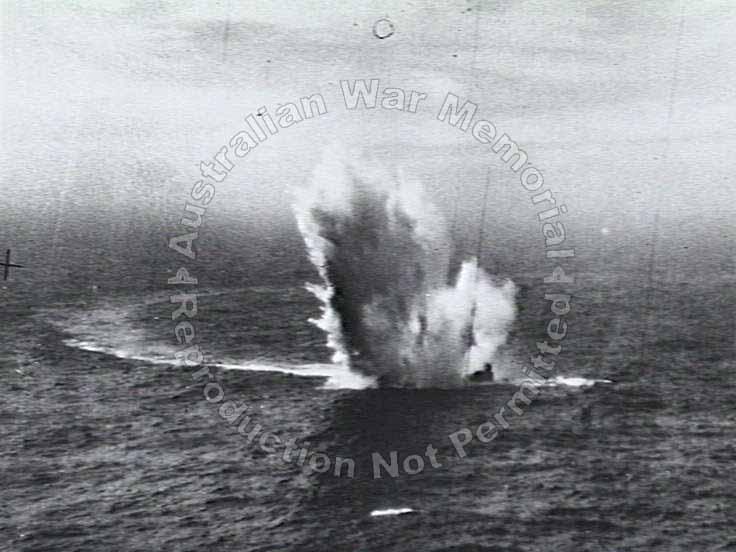
|
At
sea in the North Atlantic. 1943-06-22. 404063 Flight Lieutenant
(Flt Lt) A. W. Fraser DFC and Bar of Millaa Millaa, Qld, succeeded
in sinking a German U-boat in the face of intense gunfire from the
submarine. Although the aircraft, a Coastal Command Liberator of
No. 120 Squadron RAF, was damaged, the pilot brought it back to
base and made a perfect landing. For his "magnificent
example of determination to destroy the enemy in the face of
opposition", Flt Lt Fraser was awarded an immediate bar to
his DFC. Towering plumes of water covered the submarine as it
attempted to take evasive action.
|
|
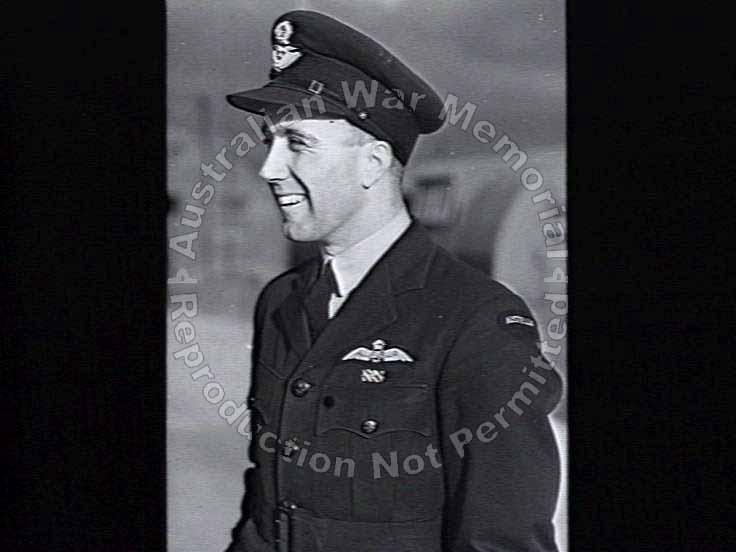
|
Reykjavik,
Iceland. C. 1943-06. Flight Lieutenant (Flt Lt) A. W. Fraser of
Millaa Millaa, Qld, the captain of a Coastal Command Liberator of
No. 120 Squadron RAF, was successful in sinking a German U-boat in
the face of intense gunfire from the submarine. For his part in
the attack Flt Lt Fraser was awarded an immediate Bar to his DFC.
|
|
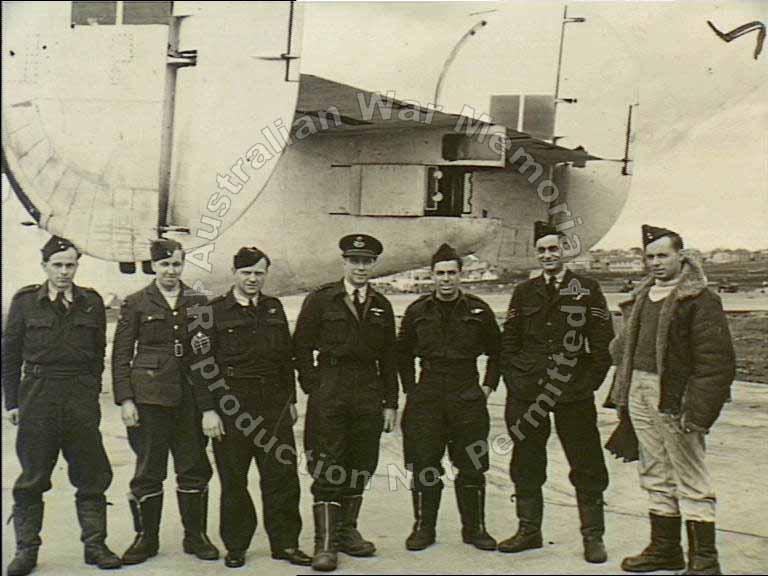
|
Reykjavik,
Iceland. C. 1943-06. Group portrait of 404063 Flight Lieutenant
(Flt Lt) A. W. Fraser DFC and Bar of Millaa Millaa, Qld (centre),
and his crew who succeeded in sinking the surfaced U-boat U194
in the face of intense gunfire from the submarine. Although the
aircraft, a Coastal Command Liberator of No. 120 Squadron RAF, was
severely damaged, Flt Lt Fraser brought it back to its base at
Reykjavik, and made a perfect precautionary approach and
successful landing. For his "magnificent example of
determination to destroy the enemy in the face of opposition,"
Flt Lt Fraser was awarded an immediate bar to his DFC.
|
Millaa
Millaa, Queensland,
Australia
http://www.holidaynq.com.au/AthertonTabs/AthertonTablelands/AthertonTablelands.html
|
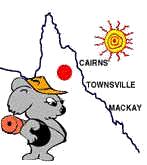
|
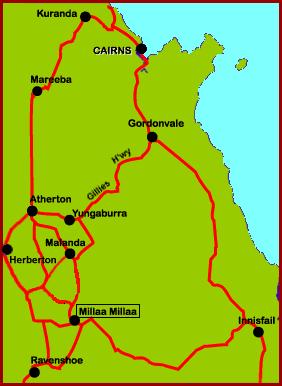
|
|
The
towns of Mareeba, Kuranda, Tolga, Atherton, Malanda, Tinaroo,
Kairi, Millaa Millaa, Ravenshoe, Yungaburra and Herberton make up
the Atherton Tablelands with lots of accommodation in either
motel, caravan park and units as well as Homestay.
You
can enjoy barramundi and fresh water fishing, cruise and swim the
lakes, historic steam train rides and birdwatching.
World
heritage rainforests... mountains... rivers... lakes in extinct
volcanos and magnificent waterfalls. All this is around an hour
from the coast and about as far from where the outback starts.
That's
just part of this benign and fertile plateau reaching up to 1000
metres above sea level. Primitive ferns hang from and around giant
Kauri pines as they've done for hundreds of years. There's
strangler figs with roots hanging more than 15 metres to the
ground.
Tree
climbing kangaroos, cassowaries, possums and bower birds inhabit
the rainforests while platypus play in the rivers and streams of
the area. There's even a vineyard and most houses have fireplaces
for the cold winter nights.
|
Type
VIIC U-boat
http://uboat.net/types/viic.htm
|
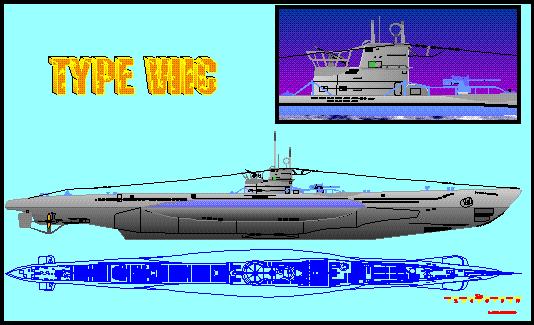
|
|
568
were commissioned from 1940 - 1945
Type
VIIC was a slightly modified version of the successful VIIB. They
had basically the same engine layout and power, but were slightly
larger and heavier which made them not quite as fast as the VIIB.
5 torpedo tubes (4 at the bow and one at the stern) were
installed. It would carry 11 torpedoes onboard or 22 TMA (=33 TMB)
mines, and also had the effective 88mm fast-firing deck gun with
about 160 rounds of ammunition.
The
VIIC was the workhorse of the German U-boat force in World War Two
from 1941 onwards and boats of this type were being built
throughout the war. The first VIIC boat being commissioned was the
U-69 in 1940. The VIIC was an effective fighting machine and was
seen in almost all areas where the U-boat force operated although
their range was not as great as the one of the larger IX types.
The
VIIC came into service as the "Happy Days" were almost
over and it was this boat that faced the final defeat to the
Allied anti-submarine campaign in late 1943 and 1944.
|
|
U-boat
|
Builder
|
Werk
number
|
Built
|
|
U-77
- U-82
|
Vegesacker
Werft, Vegesack
|
5
- 10
|
1940
- 1941
|
|

|
(from
the book Black May)
|
Length
~220 feet Size: 761 tons Engines: 6 fast or 2 slow-running diesel
Compliment: 44 + 4 ofcrs.
Surface speed: 17 knots Submerged
speed: 8 knots
Steering: Twin rudders Max time underwater: 18
hours Range: 6500 mi Number built: 700
Weapons: 1x20mm, 1x88mm
Torpedoes: 14 (typically 12 type G7e [electric], 2 type G7a
[air-turbine])
|
U-boat
Shipyards Vegesacker Werft, Vegesack
http://uboat.net/technical/shipyards/vegesack.htm
|
Built
74 U-boats
|
|
|
|
VIIB
|
U-73
- U-76
|
(4
boats)
|
1939
- 1940
|
|
|
|
|
|
|
VIIC
|
U-77
- U-82
|
(6
boats)
|
1939
- 1941
|
|
U-132
- U-136
|
(5
boats)
|
1940
- 1941
|
|
U-251
- U-291
|
(41
boats)
|
1940
- 1942
|
|
|
|
|
|
|
VIIC/41
|
U-292
- U-300
|
(9
boats)
|
1942-1943
|
|
U-1271
- U-1279
|
(9
boats)
|
1943-1944
|
|
The
first U-boat launched by Vegesacker Werft was U-73
on 27 July,1940.
The last U-boat launched by Vegesacker
Werft was U-1279 in May 1944.
All
U-boats launched by Vegesacker Werft were commissioned into the
Kriegsmarine.
|
Technical
information Type VIIC
http://uboat.net/types/viic.htm
|
Displacement
(tons)
|
769
sf
871 sm
1070 total
|
|
Speed
(kts)
|
17
- 17.7 sf
7.6 sm
|
|
Length
(m)
|
67.10
oa
50.50 ph
|
|
Oil
Supply
(tons)
|
105.3
/ 62.1
113.5t max
|
|
Breath
(m)
|
6.20
oa
4.70 ph
|
|
Torpedoes
Mines
|
14
26
TMA
|
|
Draught/
Height
(m)
|
4.74
9.60
|
|
Crew
|
44
- 52
|
|
Power
(hp)
|
2800
-
3200 ehp sf
750 ehp sm
|
|
Max
Depth
|
ca.
220 m
|
|
sm
= submerged, sf = surfaced, ph = pressure hull, oa = overall, hp =
horsepower.
|
Type
IXD U-boat Atlantikboot
http://uboat.net/types/ixd.htm
|
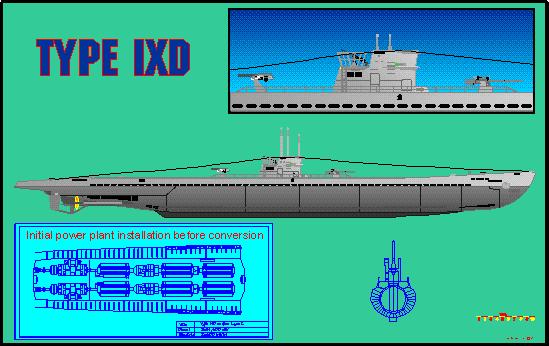
|
|
These
boats, designed in 1939-40, have been called IXD/41, IXD or IX D1
and IX D2. The difference between D1 and D2 was only in engine
layout and power, the D1 had teething troubles and the D2 boats
had a more proven layout.
These
were more than 500 tons heavier and almost 10 meters longer than
the IXC/40. They were armed with 24 torpedoes in 6 tubes (4 at the
bow and 2 at the stern) and had the secondary armament in the form
of the Utof 105mm/45 deck gun with roughly 150 rounds of
ammunition.
|
(from
the book Black May)
|
Length
~254 feet Size: 1200 tons Engines: 2 slow-running diesel
Compliment: 44 + 4 ofcrs.
Surface speed: 18 knots Submerged
speed: 8 knots
Steering: XX Max
time underwater: XX hours
Range: 24000 mi Number built: 370
Weapons: 1x
XX mm, 1x105mm Torpedoes: 24
|
Technical
information Type IXD
http://uboat.net/types/ixd.htm
|
Displacement
(tons)
|
1610
sf
1799 sm
2150 total
|
|
Speed
(kts)
|
20.8
sf
6.9 sm
|
|
Length
(m)
|
87.58
oa
68.50 ph
|
|
Oil
Supply
(tons)
|
203t
max
|
|
Breath
(m)
|
7.50
oa
4.40 ph
|
|
Torpedoes
Mines
|
24
48
TMA
|
|
Draught/
Height
(m)
|
5.35
10.20
|
|
Crew
|
55
- 63
|
|
Power
(hp)
|
4400
ehp sf
1000 ehp sm
|
|
Max
Depth
|
ca.
230 m
|
|
sm
= submerged, sf = surfaced, ph = pressure hull, oa = overall, hp =
horsepower.
|
U-boat
Flotilla Bases
7th
Flotilla http://uboat.net/flotillas/7flo.htm
|

|
Bases:
06.38 - 09.40 Kiel
09.40 - 05.41 Kiel / St. Nazaire
06.41 - 05.45 St. Nazaire
Flotilla
Commanders:
09.40 - 02.44 Korvkpt. Herbert Sohler
U-boat
types:
VIIB, VIIC, VIIC41 and UA
|
U-Flotilla
"Wegener"* was founded on 25 June 1938 under the command
of Korvkpt. Werner Sobe. The Flotilla transferred in 1940/1941 to
St. Nazaire (France). The first boat of the Flotilla, which
reached St. Nazaire was U-46 under Oblt. Engelbert Endrass on 29
Sept, 1940. In August/September 1944 most boats left the base for
Norway. The last but one flotilla boat was U-267, which left St.
Nazaire on 23 Sept, 1944.
|
|
U-96
was assigned to this flotilla. That boat was the subject of the
novel, and subsequent movie “Das Boot”.
|
23rd
Flotilla http://uboat.net/flotillas/23flo.htm
|

|
Bases:
09.41 - 05.42 Salamis (Greece)
Flotilla
Commanders:
09.41 - 05.42 Kptlt. Fritz Frauenheim (Knights
Cross)
U-boat
types:
VIIB and VIIC
|
The
23th Flotilla was founded on 11 Sept, 1941 under the command of
Kptlt. Frauenheim. The Operational area was the eastern
Mediterranean. Since May, 1942 the boats were attached to the 29th
Flotilla. The 23rd flotilla was re-founded in September, 1943 as a
training flotilla.
|
29th
Flotilla http://uboat.net/flotillas/29flo.htm
|

|
Bases:
12.41 - 08.43La Specia (Italia)
Flotilla
Commanders:
12.41 - 05.42 Korvkpt. Franz Becker
U-boat
types:
VIIB & VIIC
|
The
29th Flotilla was founded in December 1941 under the command of
Korvkpt. Franz Becker. The operational area was only the
Mediterranean. The flotilla was disbanded in September 1944, when
U-407 was sunk on 19 Sept and the two last flotilla boats U-565
and U-596 were scuttled in Salamis (Greece).
|
|
The
Wild Onager - U-338 This emblem was inspired by the launch of
U-338 which broke its mooring and sank a small tugboat. It was
adapted as the emblem for the 29th Flotilla in Las
Specia in the Mediterranean. The only boats to display the emblem
(besides the U-338) were U-77, U-371 and U-617.
|
http://uboat.net/flotillas/bases/france_map.htm
|
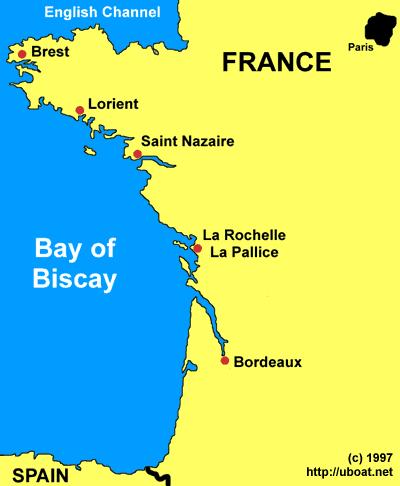
|
The
allies landed in Normany in early June 1944. Brest was captured by
the Allies on 21 Sept 1944 after a month-long battle. The town of
Lorient was reached by the US forces on 7 Aug, 1944 but was not
attacked in force and held out until May 8, 1945, same can be said
of the Saint Nazaire and La Pallice / La Rochelle bases. Bordeaux
was captured by the allies on 25 August, 1944.
|
H.M.S.
Grove
http://members.iinet.net.au/~gduncan/maritime-1.html
|
MORE
MARITIME DISASTERS OF WORLD WAR II COMPILED BY GEORGE R.
DUNCAN
HMS
GROVE (June 12, 1942) British destroyer, captained by Cdr.
J.W. Rylands, was escorting a convoy from Alexandria to to the
island of Malta when the convoy was spotted by enemy aircraft and
soon an intensive attack developed by bombers and submarines and
units of the Italian Navy. The Grove was hit by a torpedo and sank
taking the lives of two officers and 108 ratings. The enemy attack
was so severe that part of the convoy was compelled to return to
Alexandria. Also sunk in this engagement was the light cruiser HMS
Hermione which went down with eight officers and 79 ratings.
|
The
information above is in disagreement with that found elsewhere. Both
the U-boat and British_Ships_Destroyers web pages indicate that it
was a German submarine that sank the ship. Also, the mission is
listed here as escorting an Alexandria to Malta convoy, but other
sources state that the ship was returning to Alexandria from Tobruk.
The box below lists
events taking place at the time the ship was sunk. The Grove might
have been part of the second convoy.
http://home.flash.net/~hfwright/dl10ju42.htm
|
WORLD
WAR II PLUS 55 June 10-13th, 1942 by David H. Lippman
|
|
June
11th, 1942...
Two
convoys set sail for Malta, "Harpoon" from Gibraltar
being the first. This force features five freighters, an American
tanker, Kentucky, an AA cruiser, nine destroyers, and four
minesweepers, all British . The covering fore to the Sicilian
Channel consists of two carriers, a battleship, three cruisers,
and eight destroyers.
The
second convoy, leaving from Port Said, has 11 freighters,
escorted by seven light cruisers and 26 destroyers, reinforced by
the already strained Royal Navy Eastern Fleet front he Indian
Ocean. The two convoys face German and Italian aircraft, E-boats,
and submarines, not to mention the Italian Navy, with its 15-inch
gun battleships.
|
http://website.lineone.net/~jimmer/WW2.html
http://website.lineone.net/~jimmer/HTM-DE-hunt.html
|
Name
|
Pennant
|
Builder
|
Completed
|
Fate
|
|
Grove
|
L77
|
Swan
Hunter
|
5/2/42
|
Torpedoed
by U-boat U.77 off Sollum 12 June 42
|
|

|
|
1:600
Hunt class group 2, HMS Badsworth. © Andrew Arthur
|
|
The
Hunt class evolved from the unsuitability of converting old fleet
destroyers to escort destroyers. The main reasons why such a class
were needed was, firstly, that a new, utilitarian design could be
built quicker than older construction became available for
conversion, and secondly, that the high speed of the older
destroyers was wasted as escorts, asdics not working effectively
at anything over 20 knots. A small design with dual-purpose main
guns, no torpedoes, a light AA armament and a speed of around 25
knots would be cheap, quick and economical to build, and be ideal
for both anti-submarine and anti-aircraft escorts.
The
pre-war sloop HMS Bittern was seen as the most desirable model,
displacing 1090 tons, being 282 feet in length, making 18.75 knots
and armed with three twin 4" AA controlled by a HA director,
with fin stabilisers to provide a good firing platform. However,
to do all that and more ( 27 knots speed and ship a quad pom-pom )
on 8 feet less beam would make a very cramped and unstable design,
and a mis-calculation in design meant that they were too unstable
and drastically nneded a reduction in top-weight. This was done by
removing the twin 4" gun inended for the aft shelter deck,
and in turn this also eased supply demands. The pom-pom was moved
from abaft the funnel to the shelter deck, and in turn had a much
greater field of fire.
The
second group had 2½ feet more beam, and so were stable
enough to accept the third 4" AA and the pom-pom was returned
to it's original position. A new, flat-faced bridge was also
designed.
Too
unstable and short-ranged for trans-oceanic work, they performed
excellent service, particualarly in the anti-aircraft role, as
East Coast, North Sea and Mediterranean escorts.
The
AA armament was strengthened in nearly all ships in group 1 and
all in group 2 by adding a single 20mm AA cannon in each wing ( at
the fo'c'sle break in Fernie only ) and nearly all group 1 and 3
group 2 fitted a 2pdr. bow-chaser to ward off MTB attacks and
cover the forward fire arcs. The lack of torpedoes was sorely felt
in the North African theatre, were opportunities often arose to
attack merchant shipping, and this resulted in the third group
replacing one twin 4" AA with a twin 21" torpedo tube
amidships. This design was only 10 tons heavier than the Group 2,
and on the same hull, but a shift in displacements needed 40 tons
of ballast to be added to keep them stable ( it probably would
have been more sensible to retain the quarterdeck and remove the
shelter deck gun, although this would have meant quite a large
blind fire-arc for the aft gun. )
Apart
from early war losses, all survivors eventually recieved AW type
286/290 on the tripod and AR type 285 on the HA director. However,
only a few ( Cotswold, Silverton, Bleasdale and Wensleydale ) had
SW type 271/272 added in-place of the searchlight, highlighting
that they were more used in the AA role, mainly because that the
corvettes / frigates / sloops were in full production and were
much more suited to the ASW role, and there were few other escort
vessels with 4 / 6 radar controlled 4" AA.
|
|
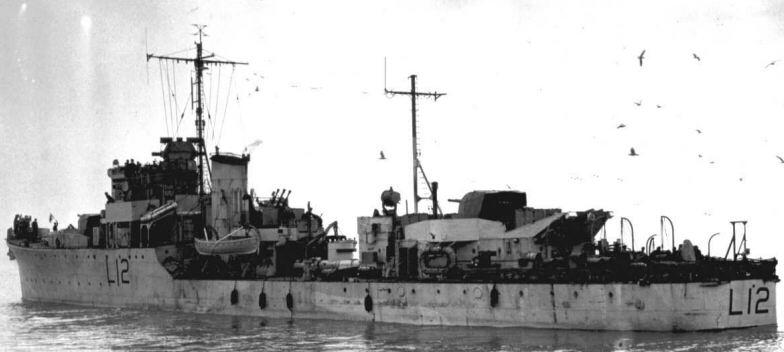
|
|
Albrighton
|
|

|
|
Adrias
|
Dimensions &
Displacements Type 2
|
|
Full
Displacement (tons)
|
1430
|
|
Empty
Displacement (tons)
|
1050
|
|
Length
(‘)
|
280
|
|
Beam
(‘)
|
31.5
|
|
Draft
(‘)
|
8.25
|
|
Performance
& Propulsion (type 2)
|
|
Machinery
|
2
x Admirality 3 drum boilers driving 2 x Parson single geared steam
turbines @ 19900 hp
|
|
Speed
|
27
kts ( 25.5 full )
|
|
Range
|
2560
/ 1100 nm @ 20 / 25.5 knots
|
Complement &
Armament
|
|
Complement
|
164
officers & ratings
|
|
Armament
|
Gun
3
x 2 x 4" AA
1 x 4 x 2pdr pom-pom AA
2 x 1 x 20mm
Oerlikon AA
1 x 2pdr 'bowchaser' in Avon Vale, Blencathra &
Liddesdale
Anti-submarine
2 x DC mortars
3 x DC
racks for 110 DC's
|
|
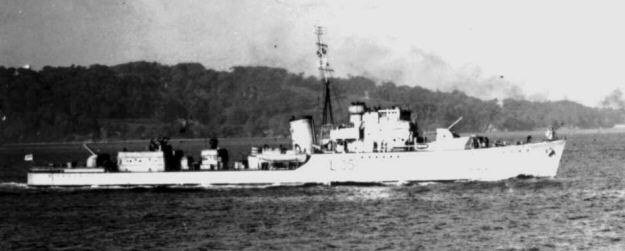
|
|
Atherstone
|
http://www.uq.net.au/~zzddelli/gbn4201a.htm#Destroyers
|
BRITISH
NAVAL STRENGTH [1 JAN 1942]: DESTROYERS
|
|
Purpose
Built
Destroyer
Escorts
|
Built
|
Afloat
|
Bldg
|
Units/Notes
|
|
'Hunt'
Class (Group II)
|
1939-42
|
28
|
3
|
Avon
Vale, Badsworth, Beaufort, Blankney, Calpe, Chiddingfold, Croome,
Dulverton, Eridge, Exmoor, Farndale, Heythrop, Hurworth, Lamerton,
Lauderdale, Puckeridge, Southwold, Tetcott, Wheatland, Bedale,
Bicester, Blackmore, Cowdray, Grove, Hursley, Ledbury,
Middleton, Wilton, Bramham, Oakley, Zetland.
|
SCALE
MODELS
http://whiteensignmodels.simplenet.com/plans.htm
|
WARSHIP
PLANS Ideal for the Scratch Builder or Super Detailer
SAMBROOK
MARINE
(P+P=Profile and Plan; LDD=Lines, Deck Plans and
Details B=Boats L=Lines M=Modifications BP=Body Plan
S=Sections)
DESTROYERS
LDD
1/96890 HMS GROVE Type II HUNT class P+P,L 1/96 9.90
|
RAF
Coastal Command
http://uboat.net/allies/aircraft/raf_coastal.htm
|
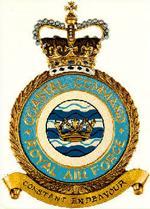
Motto:
Constant Endeavour
|
When
the war began the RAF Coastal Command was far from ready for it.
It had nothing to attack let alone sink the German U-boats. The
U-boat weapon available at the time was the anti-submarine bomb
that was far from effective and required a direct hit to do any
damage. To make matters worse the Command was always secondary to
the Bomber Command for equipment and aircraft
During
the spring of 1940 experiments were carried out to see if an
aircraft could successfully drop a depth charge (A Royal Navy
model little changed from WWI). This was proven feasible if the
aircraft was not too high or travelling too fast. Thus the MK. VII
depth charge became the new weapon for Coastal Command's aircraft.
These were later replaced by Torpex-filled depth charges with more
explosive power
The
most successful squadrons were the No. 86 and No. 120
squadrons each with 14 U-boats sunk. These were the most
successful U-boat hunters in the war.
|
(from
the book Black May)
|
Squadron
120 was the first to receive the Liberators, modified for VLR
(Very Long Range) service. In early 1943, there were five Mark I’s
and several Mark III’s based in Reykjavik. Liberator “H”,
which sunk U-200 was probably a Mark III (based on the B-24D)
|
Depth
Charges (from the book Black May)
|
The
depth charges that were used to destroy U-200 were most probably
the 250-pound “heavy” Mark VII. Their explosive was
Torpex (a mixture of Cyclonite, TNT, and aluminum flakes). The
typical setting for the depth charge was 25 feet and the aircraft
released them from a height of about 50 feet. The Liberator could
carry eight of these depth charges, and typically used them
four-at-a-time. When the charge exploded underwater, it created a
gas bubble of 3000 degrees and a pressure of 50,000 atmospheres.
It was expected that such an explosion would puncture the pressure
hull of a submarine at 20-25 feet, and damage it up to 50 feet
distance.
|
The
Consolidated B-24 Liberator
http://uboat.net/allies/aircraft/b24.htm
First
flown on 29 December 1939, the Consolidated Aircraft Corporation's
B-24 Liberator came along more than four years after the famous and
popular Boeing B-17 Flying Fortress, and showed somewhat improved
range and payload capabilities over the Fortress. Still, the
performance was in most respects quite comparable, and one might
question why the B-24 was built at all. Most, but not all, of the
missions flown by B-24s were feasible with B-17s with comparable bomb
loads. The B-24 was more difficult to fly, especially with one or
more engines out, and much less survivable when forced to ditch in
the ocean. The B-24 was also noticeably more expensive than the B-17
(averaging $295,516 per B-24 versus $223,742 per B-17) and all other
major USAAF combat aircraft of the war, excepting only the much more
advanced Boeing B-29 ($619,000).
More
of the B-24 and its derivatives were built than any other
multi-engine aircraft of the Second World War, and more than any
other American aircraft in history. Sources seem to disagree on how
many Liberators were built, with totals usually quoted between 18,188
and 19,203, making the Liberator about six percent of total American
wartime production. The differences in the totals are probably due to
the extremely complex production program. First production was at the
Consolidated factory in San Diego, California. As orders increased,
this factory was rapidly expanded until it employed 45,000 people and
eventually built 6,724 examples of the complex B-24. Demand for the
B-24 was such that even this impressive production was inadequate.
Convair (Consolidated merged with Vultee in 1941 to form Convair) set
up an additional factory in Fort Worth, Texas, and 30,000 workers
built 3,034 additional Liberators there. Additionally, Douglas
Aircraft Corporation built about 964 B-24s in its factory in Tulsa,
Oklahoma, and North American Aviation built about 966 in Dallas,
Texas. The largest Liberator factory was Ford's huge new factory
built at Willow Run, Michigan, which turned out 6,792 completed
aircraft and 1,893 disassembled, crated airframes for final assembly
elsewhere. In 1944, the Willow Run factory alone turned out
92,000,000 pounds (42,000,000 kg) of airframes, nearly equaling the
production of the entire Japanese aircraft industry that year, or
almost half of the entire German output. Peak production by all
factories produced a B-24 every 55 minutes. These factories and
several major depots also performed many conversions, often of
hundreds of aircraft. This lead to more than sixty different
designations for variations of the B-24 airframe. There were bomber,
patrol bomber, reconnaissance, cargo, tanker, trainer, experimental,
civil, and other variants.
All
versions of the Liberator were powered by the Pratt and Whitney
R-1830 Twin Wasp, a 14-cylinder air cooled radial engine. The XB-24
prototype and the six LB-30A models had R-1830-33 engines without
superchargers. Subsequent versions of the B-24, including bomber,
cargo, and trainer variants and the US Navy's PB4Y-1 had General
Electric turbo-superchargers to enhance performance at high
altitudes. The PB4Y-2 dispensed with turbo-superchargers because
their patrol bomber missions were expected to be strictly
low-altitude operations.
|

|
The
aircraft featured a high-mounted full-cantilever wing spanning 33.5
m, and most had twin tail. The last aircraft variants based on the
B-24 airframe, the XB-24K, XB-24N, YB-24N, and PB4Y-2, had a large
single tail fin. The wing was called the Davis Wing after David R.
Davis, the man who conceived the wing's advanced profile. When first
tested in a wind tunnel at the California Institute of Technology,
CalTech's engineers were hesitant to report the results because the
wing showed efficiency that exceeded what was thought possible, and
exceeded that of other contemporary wings by about 20 percent. Though
the wing, stabilizers, and fins were all-metal, the ailerons,
elevators, and rudders were fabric-covered. All versions of the
Liberator had tricycle undercarriage.
The
semi-monocoque fuselage had a boxy cross section. Bomber crews took
full advantage of the flat sides, often painting extravagant artwork,
and usually including a provocative female on the nose of the
aircraft. The bomb bay doors were a unique design which rolled up the
sides to reveal two racks in each of the two bays. A narrow catwalk
between the racks allowed brave crewmen to transit between the
forward and aft fuselage sections, or to service the bombs and racks.
Early
versions of the B-24 were heavily armed by pre-war standards, the
B-24A having two .30 caliber machine guns in the tail and six .50
caliber weapons (one in the nose, one in a ventral position, two in
an upper turret, and one on each side at the waist positions). Early
in the war, both the RAF and the USAAF found this armament
inadequate, and additional machine guns were added in subsequent
versions.
The
first major production variant was the B-24D, of which 2,738
were built. This aircraft was 20.2 m in length, spanned 33.5 m,
weighed 15,413 kg empty and 27,216 kg loaded. Powered by four Pratt &
Whitney R-1830-43 (later R-1830-65) engines of 1,200 hp, the maximum
speed was 303 mph. Armament was initially 9 .50 caliber machine guns.
Late B-24Ds received a retractable Sperry ball turret instead of the
single ventral gun, giving a total of ten .50 caliber weapons.
Officially, the B-24D could carry up to 8,000 pounds of bombs
internally. Potential maximum internal loads were 20 100-pound bombs,
12 500-pound bombs, 8 1,000-pound bombs, or 4 2,000-pound bombs. Over
Europe, B-24s delivered an average of about 4,600 pounds (2,090 kg)
of bombs per sortie, as did B-17s. In comparison with the
contemporary B17F, the B-24D cruised a little faster, but also a bit
lower.
The
USAAF and US Navy quickly perceived a need for vast numbers of B-24s,
and five large factories were eventually set up for B-24
construction. The B-24D was built by Consolidated Vultee in San
Diego, California (2,425 built) and in Fort Worth, Texas (303 built),
and by Douglas Aircraft Corporation in Tulsa, Oklahoma (10 Built).
The
B-24E was very similar to the B-24D, but had different propellers.
Consolidated produced 144 of the B-24E, while Douglas built 167, and
Ford built 490 in its huge, newly constructed factory at Willow Run,
Michigan.
The
next major production variant was the B-24G, which was also similar
to the B-24D, but introduced a power-operated nose turret. North
American built 430 of these in its Dallas factory.
The
B-24H added detail improvements, including Emerson electric nose and
tail turrets and improved waist gun mounts. Consolidated, Douglas,
and Ford built 3.100 of these.
The
B-24J was the most numerous production variant, with 6,678 being
produced by all four manufacturers. It included improved nose and
tail turrets, jettisonable waist gun mounts, a new autopilot, and an
improved bombsight. Ford and Consolidated also built 1,667 of the
B-24L, and 2,593 of the B-24M, which featured variations in the tail
gun turrets.
The
US Navy acquired many B-24Ds from the USAAF for anti-submarine
operations, and also 977 of the PB4Y-1, which were either converted
from the B-24D with the addition of an Erco nose turret, or from the
B-24J, B-24L, or B-24M with a Consolidated nose turret. Later came
736 of the much-modified PB4Y-2, with unsupercharged engines, single
tail, two upper turrets, no ball turret, twin guns in each waist
position, an extra 2.1 m added to the length of the fuselage, and
many other improvements. The PB4Y-2 was so modofied that it got a
different name, being called Privateer.
Given
the massive commitment the United States made to the B-24, it is
interesting to note that the US initially showed little interest in
the aircraft, and it was France which, in 1940, placed the first
production order for 139 of these bombers, to be called LB-30. France
surrendered long before any could be delivered, so the order was
taken over by the RAF. Twenty were taken by Coastal Command as the
Liberator I. These were very early B-24s with armor, extra machine
guns, and self-sealing fuel tanks added. They were followed by 140 of
the Liberator II, with fuselage lengthened to equal that of the
B-24D, but with Hamilton Standard propellers. These were the last of
the contract Liberators for the RAF, as all subsequent RAF Liberators
were procured through lend-lease. The Liberator III and IIIA were
based on the B-24D, the Liberator IV was derived from the B-24E,
and the Liberator V was a conversion of the B-24G. The Liberator VI
came form the B-24H and B-24J. The Liberator VII was a transport
based on the C-87 cargo variant of the Liberator. The Liberator VIII
was an improved Liberator VI, while the Liberator IX was another
Cargo variant based on the US Navy's R3Y.
One
B-24A was parked at Hickam field on the morning of December 7, 1941.
This aircraft, 40-2370, was so large that it attracted immediate
attention from Japanese bombers and became the first American
aircraft destroyed by enemy action in the Second World War.
Service
in the Atlantic Ocean
The
Liberator contributed heavily in the Atlantic battles. According to
one author, RAF Coastal Command Liberators sank, or assisted in
sinking, 70 U-boats, starting with U-597 sunk off Iceland 12 October,
1942 (by No. 120 Squadron). [but this date seems incorrect, the
sinking must have occurred earlier]






